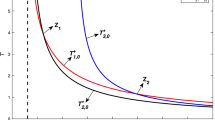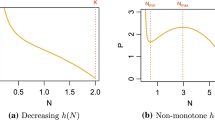Abstract
Memory allows organisms to forecast the future on the basis of experience, and thus, in some form, is important for the development of flexible adaptive behavior by animal communities. To model memory, we use the concept of hysteresis, which mathematically is described by the Preisach operator. As a case study, we consider anti-predator adaptation in the classic Lotka-Volterra predator-prey model. Despite its simplicity, the model allows us to naturally incorporate essential features of an adaptive system and memory. Our analysis and simulations show that a system with memory can have a continuum of equilibrium states with non-trivial stability properties. The main factor that determines the actual equilibrium state to which a trajectory converges is the maximal number achieved by the population of predator along this trajectory.










Similar content being viewed by others
Notes
The neutral patch \(\omega _0\) may play the role of a transport route.
As \(\mu (\alpha _R,\alpha _S)=0\) outside the triangle \(0\le \alpha _R<\alpha _S\le 1\), we can restrict the location of admissible pairs \((\alpha _R,\alpha _S)\) to this triangle only.
References
Acar M, Becskei A, van Oudenaarden A (2005) Enhancement of celluar memory by reducing stochastic transitions. Nature 435:228–232
Acar M, Mettetal JT, van Oudenaarden A (2008) Stochastic switching as a survival strategy in fluctuating environments. Nat Genet 40(4):471–475
Beauchamp G (2004) Reduced flocking by birds on islands with relaxed predation. Proc R Soc Lond Ser B Biol Sci 271(1543):1039–1042
Beaumont HJE, Gallie J, Kost C, Ferguson GC, Rainey PB (2009) Experimental evolution of bet hedging. Nature 462:90–93
Blumstein DT, Daniel JC (2005) The loss of anti-predator behaviour following isolation on islands. Proc R Soc Lond Ser B Biol Sci 272(1573):1663–1668
Brokate M, Sprekels J (1996) Hysteresis and phase transitions. Springer, Berlin
Brokate M, Pokrovskii A, Rachinskii D, Rasskazov O (2005) Differential equations with hysteresis via a canonical example. In: Mayergoyz I, Bertotti G (eds) The science of hysteresis, vol I, chap II. Elsevier, Academic, Amsterdam, pp 125–291
Castellano C, Fortunato S, Loreto V (2009) Statistical physics of social dynamics. Rev Mod Phys 81(2):591–646
Chang DE, Leung S, Atkinson MR, Reifler A, Forger D, Ninfa AJ (2010) Building biological memory by linking positive feedback loops. Proc Natl Acad Sci 107(1):175–180
Chiorino G, Auger P, Chassé JL, Charles S (1999) Behavioral choices based on patch selection: a model using aggregation methods. Math Biosci 157:189–216
Clayton NS, Griffiths DP, Emery NJ, Dickinson A (2001) Elements of episodic memory in animals. Philos Trans R Soc Lond B 356:1483–1491
Collett TS, Collett M (2002) Memory use in insect visual navigation. Nat Rev Neurosci 3:542–552
Costello JH, Strickler JR, Marrasé C, Trager G, Zeller R, Freise AJ (1990) Grazing in a turbulent environment: behavioural response of a calanoid copepod, contropages hamatus. Proc Natl Acad Sci USA 87:1648–1652
Dorogovtsev SN, Goltsev AV, Mendes JFF (2002) Ising model on networks with an arbitrary distribution of connections. Phys Rev E 66(016):104
Dubnau D, Losick R (2006) Bistability in bacteria. Mol Microbiol 61:564–572
Emery NJ, Clayton NS (2004) Effects of experience and social context of prospective caching strategies in scrub jays. Nature 414:443446
Emery NJ, Dally J, Clayton NS (2004) Western scrub jays (aphelocoma californica) use cognitive strategies to protect their caches from thieving conspecifics. Anim Cognit 7:3743
Friedman G, McCarthy S, Rachinskii D (2014) Hysteresis can grant fitness in stochastically varying environment. PLOS One 9(7):e103,241
Graziani S, Silar P, Daboussi MJ (2004) Bistability and hysteresis of the ‘secteur’ differentiation are controlled by a two-gene locus in nectria haematococca. BMC Biol 2(18):1–19
Ham TS, Lee SK, Keasling JD, Arkin AP (2008) Design and construction of a double inversion recombination switch for heritable sequential genetic memory. PLoS One 3(7):e2815
Harris RS (2005) Pressure-volume curves of the respiratory system. Respir Care 50(1):78–98
Hausrath AR (1994) Analysis of a model predator-prey system with refuges. J Math Anal Appl 181:531–545
Hawkins RD, Kandel E, Bailey CB (2006) Molecular mechanisms of memory storage in aplysia. Biol Bull 210:174191
Honey CJ, Sporns O, Cammoun L, Gigandet X, Thiran JP, Meuli R, Hagmann P (2009) Predicting human resting-state functional connectivity from structural connectivity. Proc Natl Acad Sci USA 106:2035–2040
Hoppensteadt FC, Jäger W (1980) Pattern formation by bacteria. In: et al WJ (ed) Biological growth and spread, Lect. Notes in Biomath., vol 38. Springer, Berlin, pp 68–81
Jumars PA (1993) Concepts in biological oceanography: an interdisciplinary primer. Oxford University Press, Oxford
Kandel E (2001) The molecular biology of memory storage: a dialogue between genes and synapses. Science 294:10301038
Kaufmann BB, Yang Q, Mettetal JT, van Oudenaarden A (2007) Heritable stochastic switching revealed by single-cell genealogy. PLoS Biol 5(9):e239
Krasnosel’skii MA, Pokrovskii AV (1989) Systems with hysteresis. Springer, New York
Krejčí P (1996) Hysteresis. Convexity and dissipation in hyperbolic equations. Gakkotosho, Tokyo
Krejčí P, O’Kane JP, Pokrovskii A, Rachinskii D (2011) Stability results for a soil model with singular hysteretic hydrology. J Phys Conf Ser 268(1):012,016
Krivan V (1998) Effects of optimal antipredator behavior of prey on predator-prey dynamics: the role of refuges. Theor Popul Biol 53(2):131–142
Krivan V (2007) The lotka-volterra predator-prey model with foraging-predation risk trade-offs. Am Nat 170(5):771–782
Krivan V (2009) Evolutionary games and population dynamics. In: Drabek P (ed) Proceedings of Seminar in Differential Equations, Kamenice and Lipou, vol II. Vydavatelsky servis, Plzen, pp 223–233
Kussell E, Lieber S (2005) Phenotypic diversity, population growth, and information in fluctuating environments. Science 309:2075–2078
Lai K, Robertson MJ, Schaffer DV (2004) The sonic hedgehog signaling system as a bistable genetic switch. Biophys J 86:2748–2757
Lim HN, van Oudenaarden A (2007) A multistep epigenetic switch enables the stable inheritance of dna methylation states. Nat Genet 39:269–725
Lunt ID, Spooner PG (2005) Using historical ecology to understand patterns of biodiversity in fragmented agricultural landscapes. J Biogeogr 32:1859–1873
Maamar H, Raj A, Dubnau D (2007) Noise in gene expression determines cell fate in bacillus subtilis. Science 317:526–529
Mayergoyz I (2003) Mathematical models of hysteresis and their applications. Elsevier, New York
McCarthy S, Rachinskii D (2014) Dynamics of systems with Preisach memory near equilibria. Mathematica Bohemica 139(1):39–73
McNair JM (1986) The effects of refuges on predator-prey interactions: a reconsideration. Theor Popul Ecol 29:38–63
Menzel R, Greggers U, Smith A, Berger S, Brandt S, Bundrock G, Plumpe T, Schaupp F, Silke S, Stindt J, Stollhoff N, Watzl S (2006) Honey bees navigate according to a map-like memory. Proc Natl Acad Sci 102:3040–3045
Noori HR (2014) Hysteresis phenomena in biology. Springer, New York
Ozbudak EM, Thattai M, Lim HN, Shraiman BI, van Oudenaarden A (2004) Multistability in the lactose utilization network of escherichia coli. Nature 427:737–740
Pastor-Satorras R, Vespignani A (2001) Epidemic spreading in scale-free networks. Phys Rev Lett 86:3200–3203
Pimenov A, Rachinskii D (2009) Linear stability analysis of systems with Preisach memory. Discret Contin Dynam Syst Ser B 11(4):997–1018
Pimenov A, Rachinskii D (2014) Homoclinic orbits in a two-patch predator-prey model with preisach hysteresis operator. Mathematica Bohemica 139(2):285–298
Pimenov A, Rachinskii D (2016) Robust homoclinic orbits in planar systems with preisach hysteresis operator. Conf Ser J Phys 727:012012
Pimenov A, Kelly TC, Korobeinikov A, O’Callaghan MJ, Pokrovskii AV (2010) Systems with hysteresis in mathematical biology via a canonical example. In: Wilson CL (ed) Mathematical modeling, clustering algorithms and applications, Chap 10. Nova Science Publishers Inc, New York
Pimenov A, Kelly TC, Korobeinikov A, O’Callaghan MJ, Pokrovskii AV, Rachinskii D (2012) Memory effects in population dynamics: spread of infectious disease as a case study. Math Model Nat Phenom 7:204–226
Pimenov A, Kelly TC, Korobeinikov A, O’Callaghan MJA, Rachinskii D (2015) Adaptive behaviour and multiple equilibrium states in a predator-prey model. Theor Popul Biol 101:24–30
Pokrovskii A, Rachinskii D (2013) Effect of positive feedback on devil’s staircase input-output relationship. Discret Contin Dyn S 6(4):1095–1112
Pokrovskii A, Power T, Rachinskii D, Zhezherun A (2006) Differentiability of evolution operators for dynamical systems with hysteresis. J Phys Conf Ser 55:171
Preisser EL, Bolnick DI (2008) The many faces of fear: comparing the pathways and impacts of nonconsumptive predator effects on prey populations. PLoS One 3:e2465
Preisser EL, Bolnick DI, Benard MF (2005) Scared to death? the effects of intimidation and consumption in predator prey interactions. Ecology 86:501–509
Rao CV, Wolf DM, Arkin AP (2002) Control, exploitation and tolerance of intracellular noise. Nature 420:231–237
Ruxton GD (1995) Short term refuge use and stability of predator-prey models. Theor Popul Ecol 47:1–17
Schreiber SJ, Lipcius RN, Seitz RD, Long WC (2006) Dancing between the devil and deep blue sea: the stabilizing effect of enemy-free and victimless sinks. Oikos 113(1):67–81
Sethna JP, Dahmen K, Myers CR (2001) Crackling noise. Nature 410:242–250
Shi J, Jiang J (2009) Bistability dynamics in structured ecological models. In: Cantrell S, Cosner C, Ruan S (eds) Spatial ecology, chap 3. Chapman and Hall/CRC, Florida, pp 33–61
Smits WK, Kuipers OP, Veening JW (2006) Phenotypic variation in bacteria: the role of feedback regulation. Nat Rev Microbiol 4:259–271
Thattai M, van Oudenaarden A (2004) Stochastic gene expression in fluctuating environments. Genetics 167:523–530
Thattai M, Shraiman B (2003) Metabolic switching in the sugar phosphotransferase system of escherichia coli. Biophys J 85:744–754
Tulving E (2002) Episodic memory: from mind to brain. Ann Rev Psychol 53:1–25
Visintin A (1994) Differential models of hysteresis. Springer, Berlin
Wanga L, Walkera BL, Iannacconeb S, Bhatta D, Kennedya P, Tse W (2009) Bistable switches control memory and plasticity in cellular differentiation. PNAS USA 106(16):6638–6643
Wolf DM, Fontaine-Bodin L, Bischofs I, Price G, Keasling J, Arkin AP (2008) Memory in microbes: quantifying history-dependent behaviour in a bacterium. PLoS One 3(2):e1700
Author information
Authors and Affiliations
Corresponding author
Additional information
AP was supported by SFB-787 of the DFG. AK was supported by the Ministry of Economics of Spain via Ramón y Cajal Fellowship RYC-2011-08061 and Grant MTM2015-71509-C2-1-R, by CONACYT (Mexico) via Grant N219614, and by AGAUR (Generalitat de Catalunya) via Grant 2014SGR-1307. DR was supported by the National Science Foundation Grant DMS-1413223.
Rights and permissions
About this article
Cite this article
Pimenov, A., Kelly, T.C., Korobeinikov, A. et al. Memory and adaptive behavior in population dynamics: anti-predator behavior as a case study. J. Math. Biol. 74, 1533–1559 (2017). https://doi.org/10.1007/s00285-016-1065-6
Received:
Revised:
Published:
Issue Date:
DOI: https://doi.org/10.1007/s00285-016-1065-6




